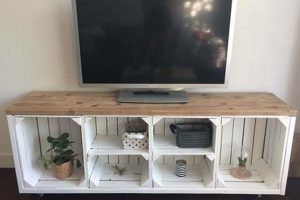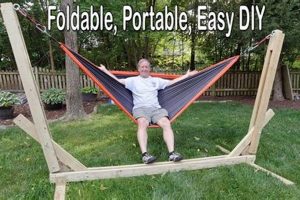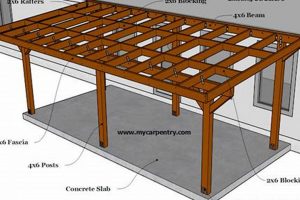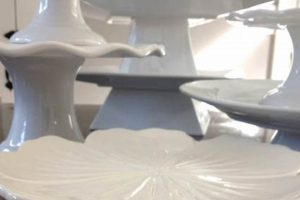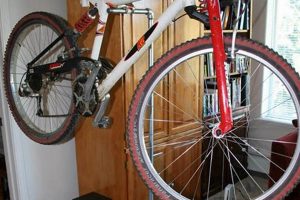Construction of a self-made support structure for outboard engines allows for convenient storage, maintenance, and transportation. These fabricated stands provide a stable platform for working on the motor outside of its marine environment, facilitating tasks such as propeller changes, oil replacements, and general inspection. The design often incorporates features like adjustable height settings and casters for enhanced maneuverability.
The creation of a personalized support offers several advantages. It reduces strain on the user during engine handling, minimizes the risk of damage to the motor from improper storage, and provides a dedicated workspace for repairs. Historically, such constructions have arisen from a need for affordable alternatives to commercially available products, driven by resourcefulness and the desire to tailor the stand to specific engine dimensions and workshop layouts.
The following sections will address materials selection, construction techniques, design considerations, and safety protocols associated with creating an effective and durable engine support structure. Furthermore, this article will discuss variations in design to accommodate different engine sizes and the inclusion of features for specific maintenance tasks.
Tips for Outboard Engine Support Construction
The following guidelines enhance the effectiveness and safety of a self-constructed outboard engine support. Adherence to these principles contributes to a durable and reliable platform for engine maintenance and storage.
Tip 1: Material Selection: Prioritize corrosion-resistant materials. Pressure-treated lumber or steel coated with rust inhibitors provide longevity, particularly in marine environments. The material’s load-bearing capacity should exceed the engine’s weight by a significant margin.
Tip 2: Secure Fasteners: Employ high-grade bolts and screws for assembly. Welded joints, where applicable, should be performed by a certified professional to ensure structural integrity. Regular inspection of fasteners is necessary to prevent loosening over time.
Tip 3: Stable Base Design: A wide, stable base minimizes the risk of tipping. Consider a square or rectangular base with evenly distributed weight. Casters, if used, must be heavy-duty and lockable to prevent unintended movement during use.
Tip 4: Engine Mounting Interface: Replicate the engine’s transom mounting points accurately. This ensures a secure and stable fit, preventing stress on the engine bracket. Padding or rubberized surfaces can further protect the engine from scratches or damage.
Tip 5: Height Adjustment Mechanism: Incorporating an adjustable height feature enhances versatility. A threaded rod system or a series of bolt holes allows for precise positioning, accommodating different engine models and maintenance tasks. Safety pins or locking mechanisms are crucial to prevent accidental slippage.
Tip 6: Weight Distribution Considerations: Distribute the engine’s weight evenly across the stand’s support structure. Reinforcements at critical stress points, such as the engine mounting interface and base connections, improve overall stability and prevent structural failure.
Tip 7: Safety Inspection: Prior to each use, conduct a thorough inspection of the stand. Check for signs of corrosion, cracks, loose fasteners, or any other damage that could compromise its structural integrity. Address any issues immediately.
Proper execution of these considerations ensures a safe and functional engine support, reducing the risk of injury and engine damage. A well-constructed stand simplifies engine handling and maintenance, contributing to the longevity of the outboard motor.
These tips provide a foundation for successful engine support creation. The next section outlines design considerations to further optimize the construction based on specific needs.
1. Stability
Stability constitutes a fundamental attribute of any self-constructed outboard engine support. It directly impacts user safety, prevents damage to the engine, and facilitates efficient maintenance procedures. Compromised stability can lead to accidents, equipment failure, and increased operational costs. Thus, a rigorous focus on design elements that enhance stability is paramount.
- Base Geometry and Footprint
The shape and size of the support’s base dictate its resistance to tipping. A wider base provides a larger support area, lowering the center of gravity and increasing stability. Square or rectangular bases are generally preferred over triangular or circular designs. The footprint should be appropriately sized to accommodate the engine’s weight and dimensions without compromising maneuverability. For instance, a narrow base supporting a heavy engine is inherently unstable and prone to tipping.
- Center of Gravity Management
Lowering the center of gravity enhances stability. This can be achieved by placing heavier components, such as the base structure, at the bottom of the stand. The engine’s mounting point should also be positioned as low as practically feasible. Counterweights can be incorporated into the base to further reduce the risk of overturning. Failure to manage the center of gravity can result in an unstable stand that is easily toppled, particularly when moving or working on the engine.
- Material Rigidity and Structural Integrity
The materials used in the stand’s construction must possess sufficient rigidity to resist bending or flexing under the engine’s weight. Inadequate material strength can lead to instability, as the stand may deform or collapse. Welded joints, if used, should be professionally executed to ensure structural integrity. Regularly inspecting the stand for signs of material fatigue or damage is crucial for maintaining stability over time. Compromised structural integrity can lead to catastrophic failure of the stand, resulting in engine damage and potential injury.
- Caster Selection and Locking Mechanisms
If casters are employed for mobility, their selection and integration significantly affect stability. Heavy-duty casters with locking mechanisms are essential to prevent unintended movement during use. The casters must be rated to support the combined weight of the stand and engine. The locking mechanisms should be reliable and easily engaged. Inadequate casters or malfunctioning locking mechanisms can lead to instability, particularly on uneven surfaces or during maintenance procedures.
The interplay of base geometry, center of gravity, material rigidity, and caster selection collectively determines the stability of a self-fabricated outboard engine support. Neglecting any of these facets can compromise safety and functionality. A well-designed stand prioritizes stability through careful consideration of each element, ensuring a safe and reliable platform for engine maintenance and storage.
2. Materials
The selection of appropriate materials is paramount in the creation of a durable and functional self-made outboard engine support. The engine’s weight, environmental exposure, and intended usage frequency dictate the material characteristics necessary for a successful build. Suboptimal material choices directly correlate with reduced lifespan, compromised stability, and potential structural failure of the stand. For instance, untreated lumber subjected to marine environments will rapidly degrade, leading to instability and potential collapse. The correlation is causative: the material properties directly affect the performance and safety of the finished product.
Steel, due to its high strength-to-weight ratio and weldability, is frequently employed in the construction of these supports. However, untreated steel is susceptible to corrosion, necessitating protective coatings such as powder coating or galvanization. Aluminum offers excellent corrosion resistance but possesses lower strength compared to steel, requiring careful design considerations to compensate. Wood, while cost-effective and readily available, demands pressure treatment to withstand moisture and prevent rot. The choice between these materials necessitates a careful evaluation of their respective properties in relation to the intended application. An inadequately constructed stand may lead to an engine falling during maintenance, resulting in costly repairs and potential injury. The practical significance lies in understanding that material selection dictates the stand’s ability to safely support and protect the engine.
Ultimately, the appropriate choice of materials for self-fabricated engine support balances structural integrity, corrosion resistance, cost-effectiveness, and ease of fabrication. A compromise might involve using a steel frame with a durable powder coating and incorporating pressure-treated lumber for engine mounting surfaces. The challenges lie in accurately assessing the load requirements, anticipating environmental conditions, and employing appropriate construction techniques. This knowledge forms the bedrock of any successful self-made engine support construction, minimizing risks and maximizing the lifespan of both the stand and the engine it supports.
3. Capacity
The load-bearing ability, or capacity, of a self-fabricated outboard engine support is intrinsically linked to its safe and effective operation. Capacity, in this context, refers to the maximum weight the stand can reliably support without structural failure. A stand constructed with insufficient capacity risks catastrophic collapse, leading to engine damage and potential injury. For instance, a stand built from lightweight materials designed for a small engine will fail if used to support a significantly heavier, larger engine. This highlights the direct causal relationship: inadequate capacity precipitates structural failure.
The importance of precisely calculating and adhering to the engine’s weight specification cannot be overstated. Overestimating the engine’s weight is preferable to underestimation. Design considerations must encompass a safety margin, exceeding the stated engine weight by a minimum of 25%. This buffer accounts for dynamic loads experienced during engine mounting, maintenance, and transport. Furthermore, material selection directly impacts capacity. High-tensile steel, for example, provides a superior capacity-to-weight ratio compared to wood or lower-grade metals. An understanding of material properties and structural engineering principles is essential in ensuring adequate capacity for the intended engine.
In summation, the capacity of a self-made outboard engine support represents a critical safety parameter. Accurate assessment of engine weight, implementation of a safety margin, and judicious material selection collectively ensure the stand’s structural integrity. The challenge lies in accurately estimating dynamic loads and accounting for potential material degradation over time. Prioritizing capacity throughout the design and construction phases minimizes the risk of failure and contributes to a safe and reliable engine support system. Understanding the correlation between capacity and structural integrity is the foremost factor when constructing the stand.
4. Ergonomics
Ergonomics constitutes a critical, yet often overlooked, component of self-fabricated outboard engine supports. The design of these stands directly influences the physical strain experienced by users during engine handling and maintenance. A poorly designed stand can induce awkward postures, excessive reaching, and heavy lifting, potentially leading to musculoskeletal disorders. Consider the act of rotating an engine on a stand where the mounting height is too low; this necessitates excessive bending, increasing the risk of back injury. Therefore, ergonomic considerations are not merely aesthetic improvements, but rather integral factors in ensuring user safety and efficiency.
Practical application of ergonomic principles manifests in several design features. Adjustable height mechanisms, for example, allow users to position the engine at an optimal working level, minimizing the need for bending or reaching. The inclusion of handles or grips facilitates safe and controlled engine maneuvering. Furthermore, the stand’s footprint should allow adequate clearance for movement around the engine during maintenance. As an example, a stand designed for propeller removal should allow unrestricted access to the propeller shaft without requiring the user to adopt awkward or strained positions. The challenge lies in balancing ergonomic considerations with structural integrity and material costs.
Ultimately, incorporating ergonomic principles into self-fabricated engine support construction contributes to a safer and more efficient workspace. Addressing these factors minimizes the risk of injury, enhances user comfort, and promotes productivity. Neglecting ergonomic considerations increases the likelihood of musculoskeletal issues and reduces overall efficiency. The key insight resides in recognizing that a well-designed stand not only supports the engine but also supports the user, thereby creating a more sustainable and user-friendly maintenance environment.
5. Mobility
The incorporation of mobility into a self-fabricated outboard engine support, realized through the integration of casters or wheels, directly influences its utility and practicality within a workshop or storage environment. The presence or absence of mobility dictates the ease with which the engine, mounted on the stand, can be relocated. Without mobility, repositioning the engine necessitates manual lifting or the use of separate material handling equipment, increasing the risk of injury and potentially damaging the engine. The cause-and-effect relationship is evident: lack of mobility results in cumbersome and potentially hazardous engine handling.
The importance of mobility as a component of a self-fabricated support is amplified by considering real-world scenarios. In a small workshop, the ability to easily move the engine out of the way when not in use optimizes space utilization. During maintenance procedures, the ability to rotate the engine 360 degrees on a mobile stand simplifies access to various components. The practical significance of this understanding translates to increased efficiency, reduced physical strain on the user, and minimized risk of accidental damage to the engine or surrounding equipment. Selection of appropriate casters, rated to support the combined weight of the engine and stand, is crucial for ensuring safe and reliable mobility.
The successful integration of mobility into a self-fabricated outboard engine support requires careful consideration of surface conditions, weight distribution, and caster locking mechanisms. Challenges may arise from uneven floor surfaces or the need to secure the stand in a fixed position during maintenance. Despite these challenges, the benefits of enhanced maneuverability outweigh the complexities involved. A well-designed support, equipped with appropriately sized and robust casters, provides a valuable asset for any boat owner or marine technician, streamlining engine storage, maintenance, and transportation tasks. The central idea remains: mobility augments the functionality and usability of a self-fabricated engine stand.
6. Durability
Durability constitutes a critical attribute of any self-fabricated outboard engine support. The operational environment of such stands, often involving exposure to moisture, temperature fluctuations, and the weight of the engine itself, necessitates robust construction. The longevity and safety of the stand are directly proportional to its ability to withstand these conditions without structural degradation. A stand built with materials or construction techniques lacking in durability poses a safety hazard, potentially leading to engine damage or personal injury. An example illustrates this point: A stand constructed from untreated lumber and exposed to marine environments will succumb to rot and structural failure much sooner than a stand constructed from corrosion-resistant steel. The connection is fundamentally causal: inadequate durability begets premature failure.
The importance of durability in the context of self-fabricated engine supports extends beyond immediate safety concerns. A durable stand represents a long-term investment, reducing the need for frequent repairs or replacements. This translates to cost savings and minimizes disruptions to engine maintenance schedules. Practical application involves selecting appropriate materials, such as galvanized steel or pressure-treated lumber, and employing robust construction techniques like welding or secure fastening. Regular maintenance, including inspection for corrosion or structural weaknesses, further contributes to the stand’s longevity. These actions collectively enhance the stand’s capacity to withstand environmental stressors and the weight of the engine.
In summary, durability is a paramount consideration in the design and construction of self-fabricated outboard engine supports. It directly impacts safety, reduces long-term costs, and minimizes maintenance disruptions. Overcoming the challenge of balancing durability with cost and ease of construction requires careful planning and informed material selection. Prioritizing durability ensures the stand’s continued functionality and contributes to a safer and more efficient engine maintenance environment. The key insight remains that a durable stand represents a sound investment in both safety and long-term value.
Frequently Asked Questions
The following questions address common inquiries regarding the design, construction, and utilization of self-fabricated engine supports. These answers are intended to provide clarity and guidance for individuals undertaking such projects.
Question 1: What are the primary advantages of constructing a self-fabricated outboard engine support versus purchasing a commercially available unit?
Construction of a personalized support allows for customization to specific engine dimensions and workshop layouts, frequently at a reduced cost. Commercial units may not perfectly accommodate all engine types or may incorporate features deemed unnecessary by the user. A self-fabricated solution permits tailoring the support to individual needs and preferences.
Question 2: What safety precautions should be observed during the construction of an engine support?
Eye protection, appropriate ventilation, and the use of personal protective equipment are paramount. Welding should only be performed by qualified individuals, and adherence to manufacturer’s guidelines for power tool operation is mandatory. The stand should be load-tested prior to use with an engine to verify structural integrity.
Question 3: What constitutes an acceptable safety margin when calculating the weight-bearing capacity of the support?
A minimum safety margin of 25% above the engine’s specified weight is recommended. This accounts for dynamic loads experienced during engine mounting, maintenance, and transportation. Overestimation of the engine’s weight is preferable to underestimation.
Question 4: Which materials offer the best combination of durability, corrosion resistance, and cost-effectiveness for engine support construction?
Galvanized steel provides a balance of strength, corrosion resistance, and affordability. Pressure-treated lumber is a viable option for components not directly exposed to excessive weight or moisture. The choice of material should be determined by budgetary constraints and anticipated environmental conditions.
Question 5: How can mobility be safely incorporated into the design of a self-fabricated engine support?
Heavy-duty casters with locking mechanisms are essential for safe mobility. The casters must be rated to support the combined weight of the stand and engine. The locking mechanisms should be robust and easily engaged to prevent unintended movement during use.
Question 6: What are the key maintenance procedures for ensuring the longevity of a self-fabricated engine support?
Regular inspection for corrosion, cracks, and loose fasteners is critical. Any signs of structural weakness should be addressed promptly. Periodic cleaning and application of protective coatings, such as rust inhibitors, extend the stand’s lifespan.
The aforementioned considerations represent fundamental guidelines for constructing safe and functional engine supports. Adherence to these principles enhances the likelihood of a successful project and mitigates potential risks.
The subsequent section will address advanced design considerations and specialized features that can be incorporated into self-fabricated engine supports.
Conclusion
The preceding exploration of the construction of self-fabricated outboard engine supportsa practice often termed “boat motor stand diy”underscores the importance of meticulous planning, material selection, and adherence to safety protocols. Capacity, durability, stability, ergonomics, and mobility each represent critical design parameters that must be carefully considered to ensure a safe and functional outcome. A failure to address any of these factors can compromise the integrity of the stand, potentially leading to engine damage or physical harm.
The endeavor of crafting a self-made engine support should be approached with a comprehensive understanding of structural engineering principles and a commitment to rigorous quality control. While commercially available options exist, the ability to customize a support structure to specific engine dimensions and workshop requirements remains a compelling argument for the do-it-yourself approach. Prospective builders are encouraged to thoroughly research best practices and prioritize safety above all else, recognizing that a well-executed project contributes to both operational efficiency and long-term cost savings.


